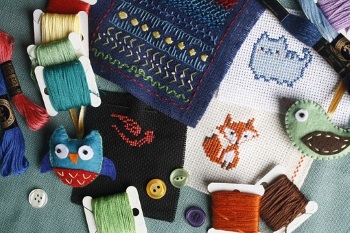
For many people making crafts is a hobby. It can be a form of relaxation, or a way to provide handmade gifts to family and friends. But some people make supplementary income by selling crafts, or even do it as a full-time job. To make money selling crafts, doing the actual crafting is only part of the process. You need to strategize, prioritize, and advertise, among other things.
Choosing Your Craft
See what sells.
Perhaps you make several types of crafts, but aren't sure which one would be a strong seller. Or maybe you want to go "all-in" on crafting for profits despite a lack of previous experience. You may want to start by seeing what others are selling successfully.
Visit craft shows in your area, local retailers that sell crafts, and websites that specialize in selling handmade items. What are other crafters trying to sell, how much are they selling it for, and do they seem to actually be making sales?
Depending on your situation, you may be seeking validation of the possible profitability of your chosen craft, or inspiration on the type of crafting to focus your energies on.
Follow your passion.
Being inspired by others is a good start, but you also need to be motivated to do the work. If you're going to make some real money by selling your wares, you'll have to dedicate substantial time and energy to making, marketing, selling, and shipping your craftwork. If your heart is not in it, your chances of success are minimal.
If you find that hand-weaved baskets seem to sell well, but you hate basket weaving and much prefer working with ceramics, you're probably best served to follow your passion. At very least, you'll "go down swinging," as they say.
Some of the work involved in selling crafts can be repetitive drudgery, so it is helpful if the creation component of it is at least stimulating and enjoyable.
Focus on quality.
Let's face it - if people want junk crafts, they will just buy mass-produced knock-offs at a big box retailer for a lower price. Many people love handmade items, but they want those hands to be skilled ones.
You need to do a reality check - is your crafting good enough to stack up to the competition? Your birdhouses or vases may be good enough to give your niece for her birthday, but are they good enough for strangers to pay real money for them?
You may want to take some time mastering your craft before jumping into sales. It is better to build a reputation for high quality craftsmanship right from the start.
Do the math.
Whether you are selling crafts, cars, or commercial real estate, you need to have some talent for running numbers and estimating costs and profits to be successful. You have to be practical about the potential profitability of your craftwork.
When establishing the "price point" for your craftwork, you need to consider the cost of materials; supplies, equipment, and possibly workspace; advertising; stocking your items for sale; shipping (especially if selling online); labor (yours and possibly others'); and the retail markup, which should probably be at least in the 30-35% range.
If you cannot produce your craft for a reasonable price while still making a profit, then you need to change your craft, streamline your methods, or forget about making money this way.
Be optimistically realistic.
However much scouting, planning, and number-crunching you do, selling crafts for a profit is always going to be a bit of a crapshoot. What works for some may not work for others, for a variety of reasons known and unknown.
Don't go into the process expecting to make big money right away, or you are bound to be disappointed. It takes time to start making money selling crafts, and even that is not always enough.
So, there is no guarantee of success, but there is also nothing that says you cannot be successful. A positive attitude can go a long way, especially during the lean times early on.
Tip: Do not purchase huge amounts of materials and spend time creating a vast amount of items until you determine what sells. The popularity of crafts often comes and goes. You may be wasting a lot of time and money creating products that will not sell.
Selling Your Wares

Sell online.
Gone are the days when crafters had to rely exclusively on craft shows. The internet can act as one giant, never-ending craft show if you utilize it well.
Etsy.com is probably the most well-known of numerous sites that focus on the sale of handmade items. There, you have the opportunity to create your own little online "shop." Make the most of it by creating an enticing name, logo, images, and descriptive stories of your business and your product(s) for sale.
Professional quality photographs of your crafts are now the standard for sales on such sites. Take the time, or pay the price, to get the best shots of your product.
If you don't know much about search engine optimization (SEO), learn. You need to choose the right titles and tags in order to direct search engine traffic to your page.
Sites like Etsy take a cut of your profits, of course. So, if you are web savvy, you may want to consider selling over your own site. This may serve you better after you have developed a solid customer base, however.
• Signing up as a seller on Etsy is free, but it costs 20 cents to list an item for four months or until it sells, whichever comes first. Etsy also collects 3.5% of the final purchase price.
Set up shop at festivals.
While online sales have superseded them for many crafters, selling at festivals and craft shows can still be a keystone of your strategy. After all, there is no better way to show the quality of your wares, and use your charms as the craftsperson, than in person.
There are many online resources that can provide information on festivals and shows nationwide and in your region.
Start with festivals in your local area, and start small. Perhaps you can "sublet" some space in another vendor's stall, for instance. Don't go "all in" until you see how your product sells.
Scout festivals first whenever possible. Get a feel for the atmosphere and whether items like yours are likely to sell well. Festival ads and reviews are helpful, but cannot replace the value of seeing things with your own eyes.
Be a people-person in your booth. Talk to people. Tell your story. If possible, conduct demonstrations of you creating your crafts, or show videos of the process.
• FestivalNet publishes the most extensive and comprehensive database of festivals and fairs in North America. they publish detailed event data on 26,000+ festivals, art shows, art and craft shows, music festivals, and other events.
Get your product into stores.
Instead of trying to compete with retailers both large and small, try to work with them. Your quality products and their customer volume can make a profitable combination.
As with craft shows, starting small and starting local in the retail setting can help you "get your feet wet" and better determine the profit viability of your craftwork.
Look first for businesses in your area that focus on selling local handmade products. Then consider retailers that sell products that are comparable or complementary to yours.
Prepare a sales pitch for owners or managers of potential retail shops. If you can provide specific information on sales projections, anticipated profits, etc., you will likely increase your odds of success.
When possible, try to negotiate an arrangement that lets you set up your crafts as a virtual shop-within-a-shop. Display your crafts together, along with business cards or other promotional materials.
Sell products out of your home.

If your specialty is framed artwork targeted toward children, ask around at pediatrician offices, kids' clothing stores, daycare centers, and the like. See if you can place some of your product and provide information about sales from your home.
Advertise with flyers, social media posts, and so on for a craft party to be held at your home. Display your product line(s), show where they are made, and work to build up an interested potential customer base.
Wherever you are selling, at home, online, or at shows or stores, make sure you know the rules. Consider applying for a tax exempt number so you can purchase materials wholesale and increase your profits.
Craft shows and websites like Etsy will have their own lists of rules and regulations that you need to know and follow to continue selling there.
Wherever you sell, you probably need to know how to collect taxes on your sales. The website or craft show may be able to help you out with advice on the process, or you may have to navigate the process alone. Don't just skip this step, assuming that no one will ever notice You could very easily regret it down the line.
How do I get a credit card machine?
You don't have to get a credit card machine if you have a smart phone. They make small devices now that plug into the headphone jack of your phone and allow you to swipe cards. However, if you want to buy a credit card machine, you can get one online on sites like Amazon
Article source: wikiHow wikiHow is a group effort to create a great resource: the world's largest free how to manual. wikiHow articles help people solve their everyday problems. wikiHow licenses all content under a Creative Commons License. The license allows wikiHow content to be used freely for noncommercial purposes. The Creative Commons License also allows for the creation of derivative works.
More Make Money With Crafts Ideas:
• Thinking of Starting an Arts and Crafts Business?
• Making Money Marketing Your Crafts
• Arts and Crafts Business Plan
• How to Make Money Using Etsy
• Build a Home Based Business Selling Crafts Online
• How to Make Sales After the Craft Show
• Your Craft Show Booth - How it can make you more money!
• Turn Your Reborn Doll Craft Into a Website
• Making Rubber Stamps With Liquid Polymer
• How to Reduce Craft Show Costs


